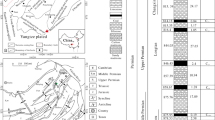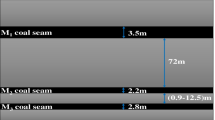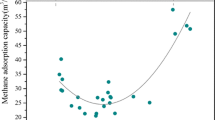Abstract
Underground coal mining operations produce large numbers of gobs that contain methane from mining coal seams and their adjacent coal seams. In longwall mining, gob methane is released to coal faces, presenting safety issues. Therefore, if gob methane sources can by identified accurately under extraction conditions, then efficient methane extraction strategies can be adopted to maximize the capture of methane from gobs and to control effectively methane flow to the coal face, thereby reducing safety risks. In this study, a new method to determine quantitatively gob methane sources under extraction conditions was proposed and tested in China’s Liyazhuang Coal Mine. Firstly, the isotope and gas composition of methane desorbed from coal cores of the mining seams and their adjacent seams, as well as methane collected from methane drainage boreholes at different heights in the gobs, were measured. Then, an isotope source model for calculating gob methane sources was established. Finally, based on isotope and gas compositions, the proportions of sources of gob methane that had been extracted from methane drainage boreholes were determined using the afore-mentioned model, and the extraction range that could maximize efficiently the control of methane emissions from each methane source was obtained.










Similar content being viewed by others
References
Aadnoy, B. S. (1989). Stresses around horizontal boreholes drilled in sedimentary rocks. Journal of Petroleum Science & Engineering, 2(4), 349–360.
Bi, J., & Jia, J. (2014). Prediction for gas emission quantity based on the compensation algorithm of PCMRA and neural network. Journal of Natural Disasters, 23(5), 198–203.
Chen, L., Wang, E. Y., Feng, J. J., Kong, X. G., Li, X. L., & Zhang, Z. B. (2016). A dynamic gas emission prediction model at the heading face and its engineering application. Journal of Natural Gas Science and Engineering, 30, 228–236.
Chen, Y. Q., Zheng, L. J., Huang, J., Zou, Z., & Li, C. H. (2020). Prediction of gas emission based on grey-generalized regression neural network. IOP Conference Series: Earth and Environmental Science, 467, 012056.
Dong, J., Cheng, Y. P., Jin, K., Zhang, H., Liu, Q. Q., Jiang, J. G., & Hu, B. (2017). Effects of diffusion and suction negative pressure on coalbed methane extraction and a new measure to increase the methane utilization rate. Fuel, 197, 70–81.
Faber, E. B., & Stahl, W. (1984). Geochemical surface exploration for hydrocarbons in the North Sea. AAPG Bulletin, 68, 363–386.
Feng, G. R., Hu, S. Y., Li, Z., Jiang, H. N., Zhang, Y. T., Xu, G., et al. (2016). Distribution of methane enrichment zone in abandoned coal mine and methane drainage by surface vertical boreholes: A case study from China. Journal of Natural Gas Science and Engineering, 34, 767–778.
Fu, H., Jiang, W., & Shan, X. X. (2012). Study on coupling algorithm on coal mine gas emission forecast model. Journal of China Coal Society, 37(4), 654–658.
Guo, X. H., Cai, W., Ma, S. Q., Jiang, Z. A., & Chen, X. X. (2010). Continuity prediction of gas emission during drivage in coal seam based on stable percolation. Journal of the China Coal Society, 35(6), 932–936.
Guo, Y. P., Guo, X. L., Guo, X. H., Hao, X. J., & Zhao, H. (2012). Prediction of gas concentration at mining face based on classical time-series analysis. Mining Safety and Environmental Protection, 39, 33–39.
Jing, Y., Rabbani, A., Armstrong, R. T., Wang, J., & Mostaghimi, P. (2020). A hybrid fracture-micropore network model for multiphysics gas flow in coal. Fuel, 281, 118687.
Jin, K., Cheng, Y. P., Wang, W., Liu, H. B., Liu, Z. D., & Zhang, H. (2016). Evaluation of the remote lower protective seam mining for coal mine gas control: a typical case study from the Zhuxianzhuang Coal Mine, Huaibei Coalfield, China. Journal of Natural Gas Science and Engineering, 33, 44–55.
Justyna, S. (2020). Polish underground coal mines as point sources of methane emission to the atmosphere. International Journal of Greenhouse Gas Control, 94, 102921.
Karacan, C. Ö., Ruiz, F. A., Cotè, M., & Phipps, S. (2011). Coal mine methane: a review of capture and utilization practices with benefits to mining safety and to greenhouse gas reduction. International Journal of Coal Geology, 86(2), 121–156.
Lunarzewski, L. W. (1998). Gas emission prediction and recovery in underground coal mines. International Journal of Coal Geology, 35(1), 117–145.
Qiao, M. Y., Ma, X. P., Lan, J. Y., & Wang, Y. (2011). Time-series gas prediction model using LS-SVR within a Bayesian framework. Mining Science and Technology, 21(1), 153–157.
Qin, Z. Y., Yuan, L., Guo, H., & Qu, Q. D. (2015). Investigation of longwall goaf gas flows and borehole drainage performance by CFD simulation. International Journal of Coal Geology, 150, 51–63.
Saghafi, A., & Pinetown, K. L. (2015). A new method to determine the depth of the de-stressed gas-emitting zone in the underburden of a longwall coal mine. International Journal of Coal Geology, 152(Part A), 156–164.
Wang, C., Wang, E. Y., Xu, J. K., & Liu, X. F. (2010). Bayesian discriminant analysis for prediction of coal and gas outbursts and application. Mining Science and Technology, 20(4), 520–523.
Wang, J. C., Yang, S. L., Li, Y., Wei, L. K., & Liu, H. H. (2014). Caving mechanisms of loose top-coal in longwall top-coal caving mining method. International Journal of Rock Mechanics and Mining Sciences, 71, 160–170.
Wang, K., Lou, Z., Guan, L. H., Zhang, X., Qin, B. B., & Huang, Y. T. (2020). Experimental study on the performance of drilling fluid for coal seam methane drainage boreholes. Process Safety and Environmental Protection, 138, 246–255.
Wei, C. R., Xu, M. Q., Sun, J. H., Li, X., & Ji, C. R. (2011). Coal mine gas emission gray dynamic prediction. Procedia Engineering, 26, 1157–1167.
Wei, L., Wu, Y. Q., Fu, H., & Yin, Y. P. (2018). Modeling and simulation of gas emission based on recursive modified elman neural network. Mathematical Problems in Engineering. https://doi.org/10.1155/2018/9013839
Wei, M. Y., Wang, E. Y., & Liu, X. F. (2020). Assessment of gas emission hazard associated with rockburst in coal containing methane. Process Safety & Environmental Protection: Transactions of the Institution of Chemical Engineers Part B, 135, 257–264.
Whiticar, M. J., Faber, E., & Schoell, M. (1986). Biogenic methane formation in marine and freshwater environments: CO2 reduction vs. acetate fermentation-Isotopic evidence. Geochimica et Cosmochimica Acta, 50, 693–709.
Wu, L. F., Liu, S. F., Chen, D., Yao, L. G., & Cui, W. (2014). Using gray model with fractional order accumulation to predict gas emission. Natural Hazards, 71(3), 2231–2236.
Yang, L., & Liu, C. C. (2013). Prediction of Gas emission based on partial correlation analysis and SVR. Applied Mathematics and Information Sciences, 7(5), 1671–1675.
Yang, Z. C., & Zhou, S. W. (2015). Modeling and prediction of daily gas concentration variation at a mining face based on the elliptic orbit model: a case study. International Journal of Mining Science and Technology, 25(6), 1045–1052.
Yuan, L. (2011). Theories and techniques of coal seam methane control in China. Journal of Rock Mechanics and Geotechnical Engineering, 3(4), 343–351.
Zhai, S. R., Nie, B. S., Liu, S. W., Wang, H., Zhao, C. H., Li, Q., et al. (2011). Model of gas concentration forecast based on chaos theory. Procedia Engineering, 26, 211–217.
Zhang, C., Tu, S. H., Bai, Q. S., Yang, G. Y., & Zhang, L. (2015). Evaluating pressure-relief mining performances based on surface gas venthole extraction data in longwall coal mines. Journal of Natural Gas Science and Engineering, 24, 431–440.
Zhang, H., Cheng, Y. P., Liu, Q. Q., Yuan, L., Dong, J., Wang, L., Qi, Y. X., & Wang, W. (2017). A novel in-seam borehole hydraulic flushing gas extraction technology in the heading face: enhanced permeability mechanism, gas flow characteristics, and application. Journal of Natural Gas Science and Engineering, 46, 498–514.
Zhang, R. L., & Lowndes, I. S. (2010). The application of a coupled artificial neural network and fault tree analysis model to predict coal and gas outbursts. International Journal of Coal Geology, 84(2), 141–152.
Zhang, X. L., Shan, J. P., & Peng, S. P. (2009). Mathematical geology technique and method for prediction of gas content and emission. Journal of the China Coal Society, 34(3), 350–354.
Zhao, W., Cheng, Y. P., Guo, P. K., Jin, K., Tu, Q. Y., & Wang, H. F. (2017). An analysis of the gas-solid plug flow formation: New insights into the coal failure process during coal and gas outbursts. Powder Technology, 305, 39–47.
Zhao, W., Cheng, Y. P., Pan, Z. J., Wang, K., & Liu, S. M. (2019). Gas diffusion in coal particles: A review of mathematical models and their applications. Fuel, 252, 77–100.
Zhou, A. T., & Wang, K. (2018). A new gas extraction technique for high-gas multi-seam mining: a case study in Yangquan Coalfield, China. Environmental Earth Sciences, 77(4), 150.1-150.16.
Acknowledgments
This research was supported by the Joint Funds of the National Natural Science Foundation of China (U1710121), the Key Research and Development (R&D) Projects of Shanxi Province (201901D111005(ZD)-3), the Project funded by China Postdoctoral Science Foundation (2020T130389), the Coalbed Methane Joint Research Foundation of Shanxi Province (2015012008), and the Shanxi Province Science and technology plan announced bidding project (20201101001). This work was also supported by the Project funded by China Postdoctoral Science Foundation, the Program for the Outstanding Innovative Teams of Higher Learning Institutions of Shanxi and the Training Program of First-class Discipline for Young Academic Backbone of Taiyuan University of Technology.
Author information
Authors and Affiliations
Corresponding author
Rights and permissions
About this article
Cite this article
Hu, L., Hu, S., Feng, G. et al. A New Method for Determining Gob Methane Sources Under Extraction Conditions of Longwall Coal Mines. Nat Resour Res 30, 2241–2253 (2021). https://doi.org/10.1007/s11053-021-09856-y
Received:
Accepted:
Published:
Issue Date:
DOI: https://doi.org/10.1007/s11053-021-09856-y




